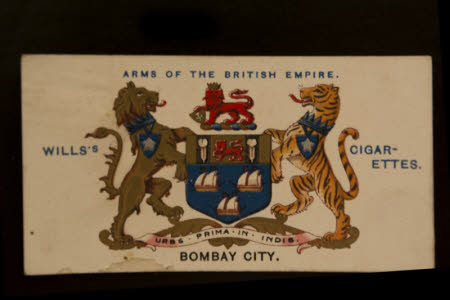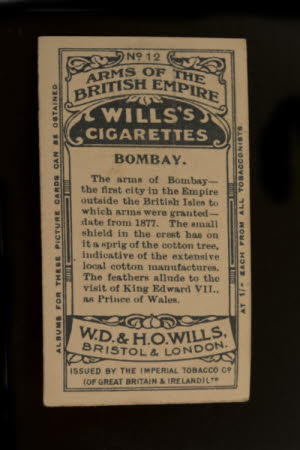Cigarette card
Category
Ephemera
Date
Unknown
Materials
card
Measurements
35 mm (Width) x 0.5 mm (Depth); 68 mm (Length)
Order this imageCollection
Mr Straw's House, Nottinghamshire
NT 749273.4.12
Summary
One of a set of 50 of Will's Cigarette cards 'Arms of the British Empire'. The first of three partail sets of cigarette cards kept in a wooden box with two compartments, a metal hinged lid painted red with a yellow / orange flower and card suit design. On the front of the card, at the top, is the title 'ARMS OF THE BRITISH EMPIRE.' To the left of the central coat of arms image it reads 'WILLS's, and then to the right 'CIGARETTES.' Beneath the image is the location the arms originate from, ‘BOMBAY CITY.' The central coat of arms consists of a blue shield with three sailing ships. Across the top of the shield is a horizontal gold band with a red lion in the centre, flanked by two white items, possibly feathers. Atop the shield is a left facing red lion wearing a gold crown and with a paw resting on a gold shield with a cross pattern. The shield is supported by a lion on the left and a tiger on the right, each with its tongue out and a blue crown round its neck, off which hangs a blue shield with a silver star. A banner beneath the crest reads 'URBS PRIMA IN INDIS.' On the rear of the card is decorative scrolling and the text at the top reads 'No12 ARMS OF THE BRITISH EMPIRE, 'WILLS'S CIGARETTES. The text at the base reads 'W.D. & H.O. WILLS.' BRISTOL & LONDON. ISSUED BY THE IMPERIAL TOBACCO Co. (OF GREAT BRITAIN & IRELAND)Ltd' Down either side of the card there is text running vertically which in its entirety reads 'ALBUMS FOR THESE PICTURE CARDS CAN BE OBTAINED AT 1/- EACH FROM ALL TOBACCONISTS.' In the centre of the rear of the card the decoration creates a box for information specific to the location portrayed on the card. In this instance it reads ‘The arms of Bombay - the first city in the Empire outside the British Isles to which arms were granted - date from 1877. The small shield in the crest has on it a sprig of the cotton tree, indicative of the extensive local cotton manufacturers. The feathers allude to the visit of King Edward VII., as Prince of Wales.'

